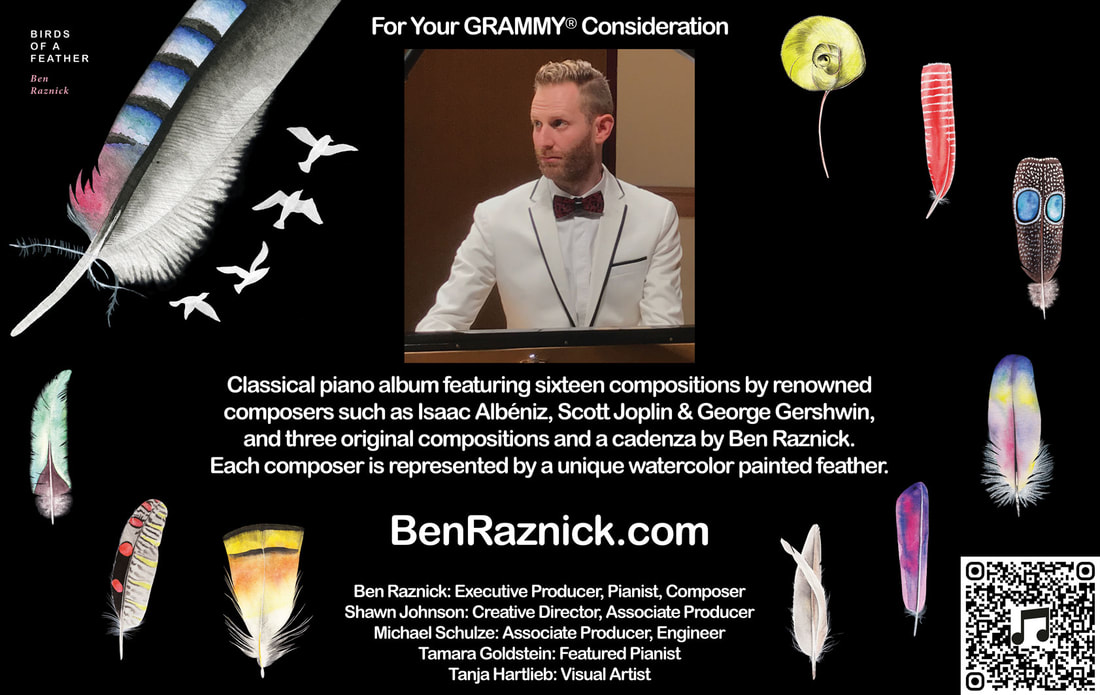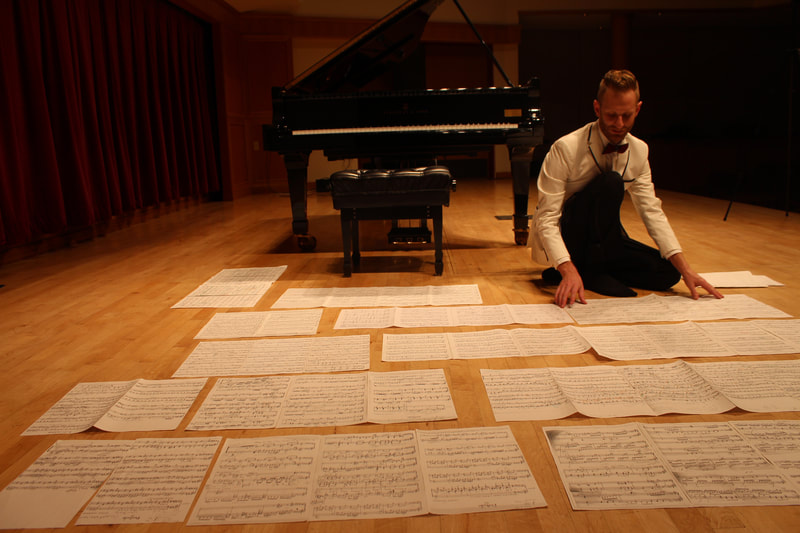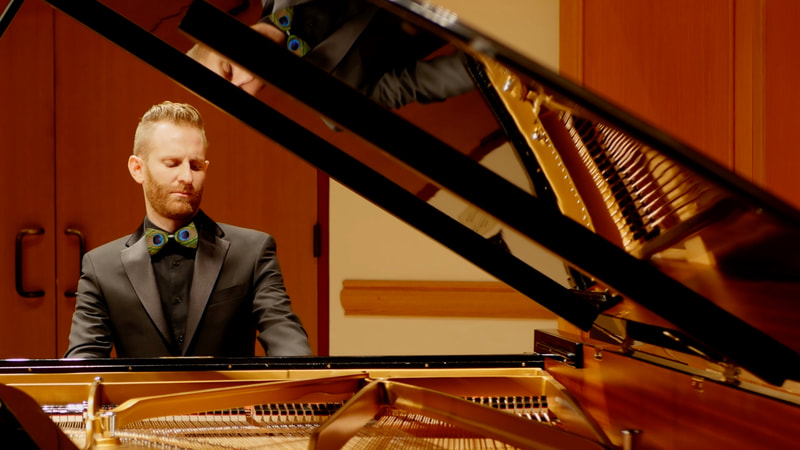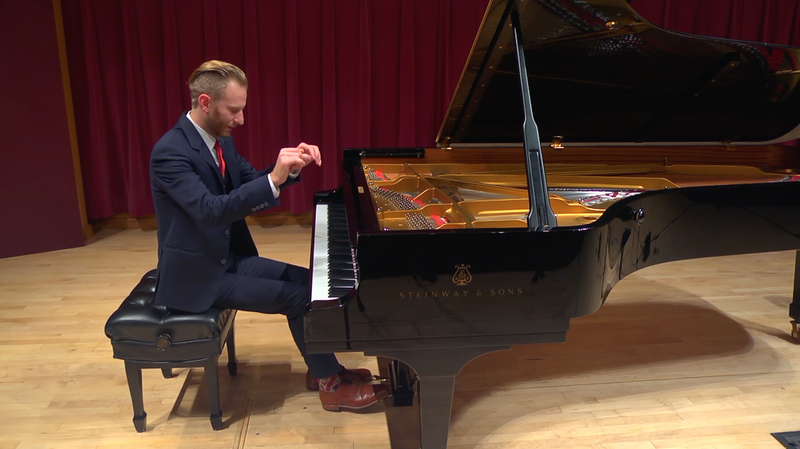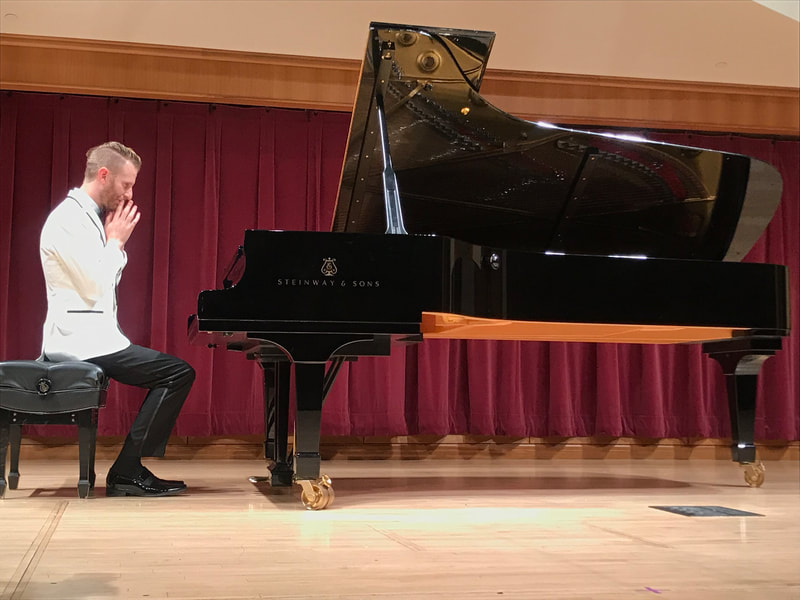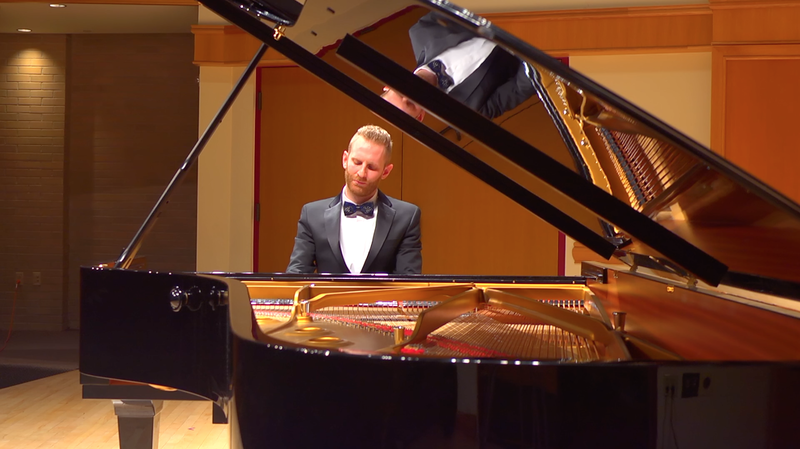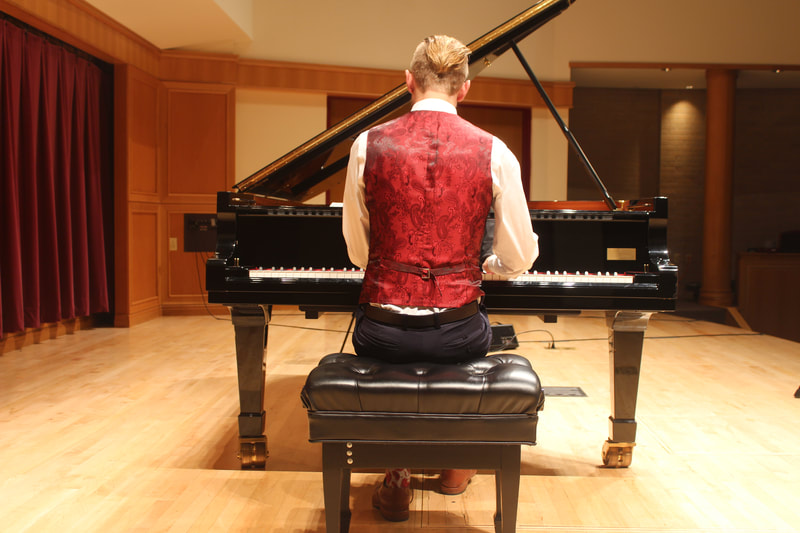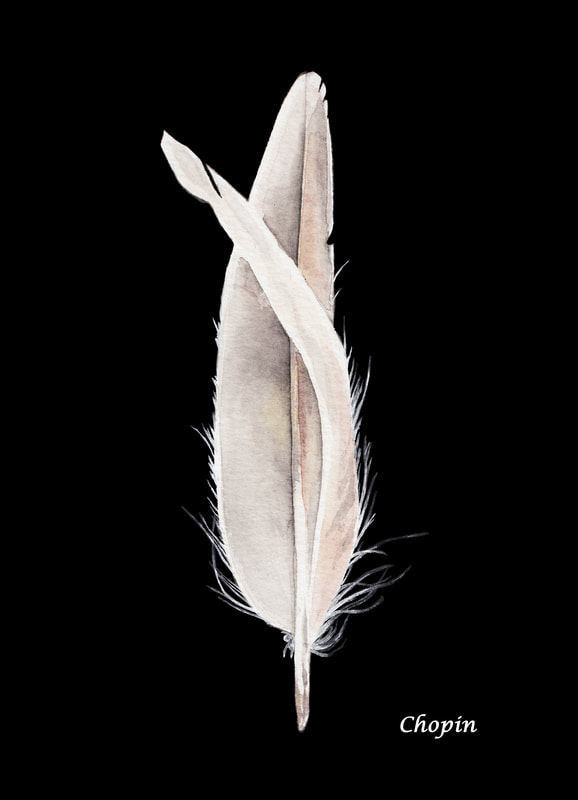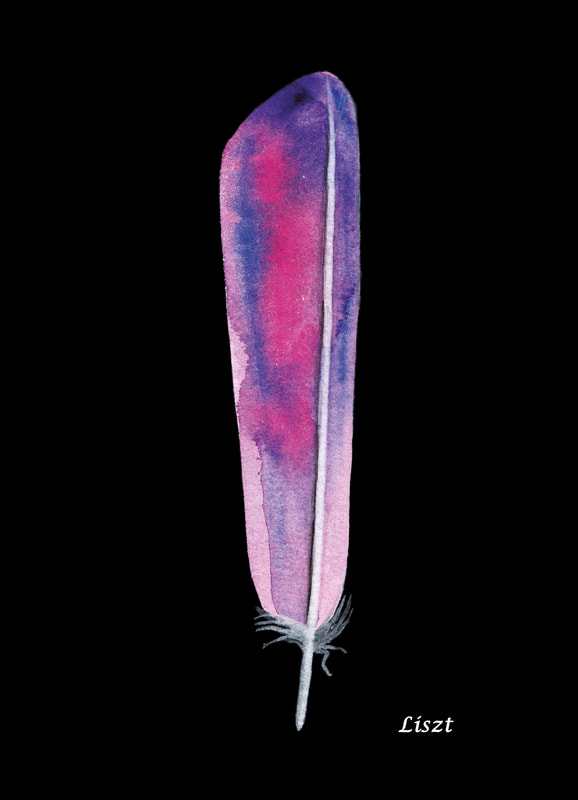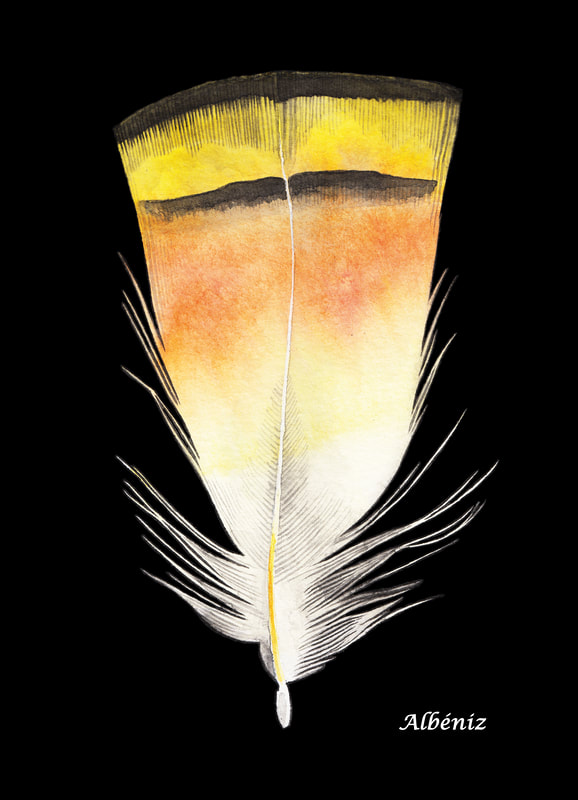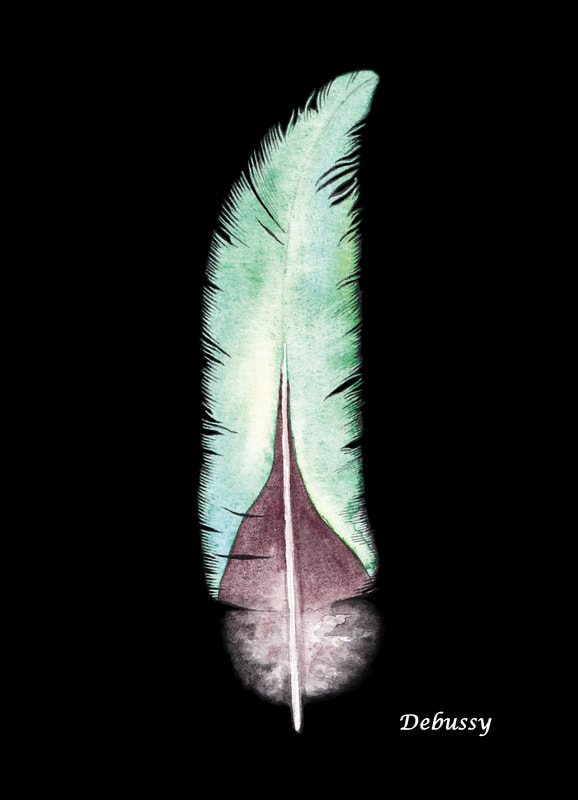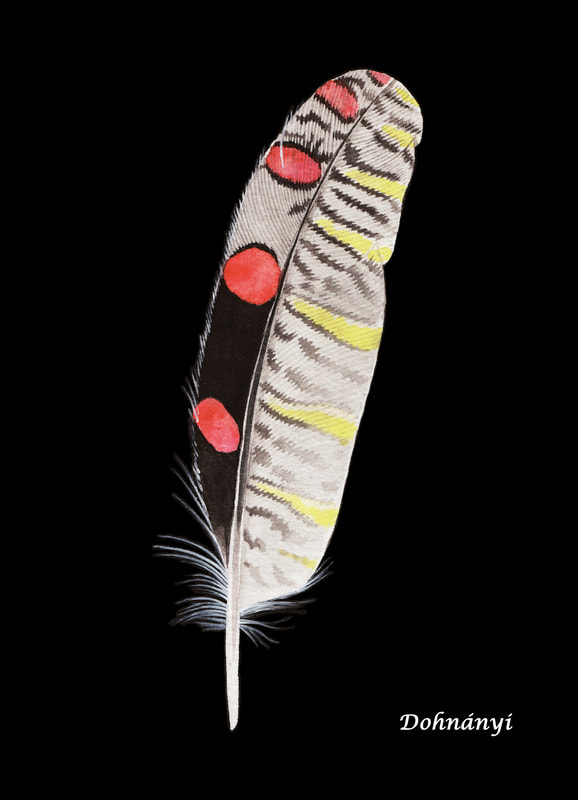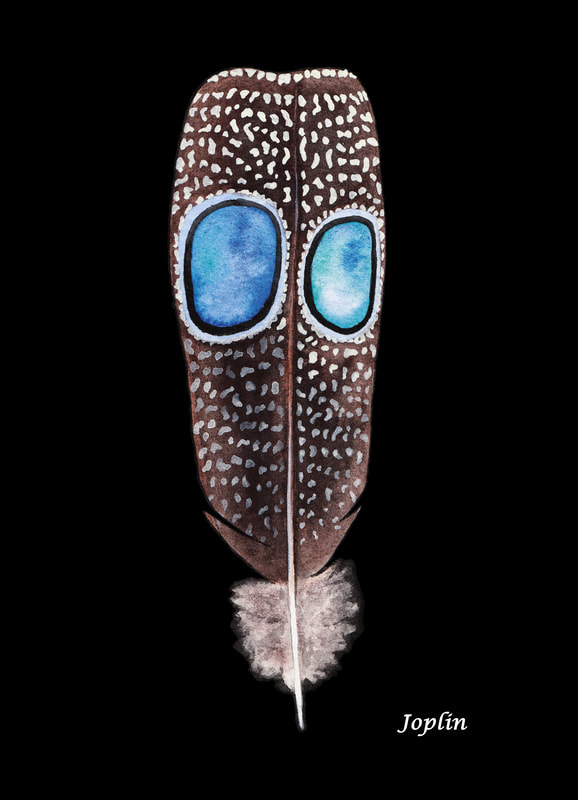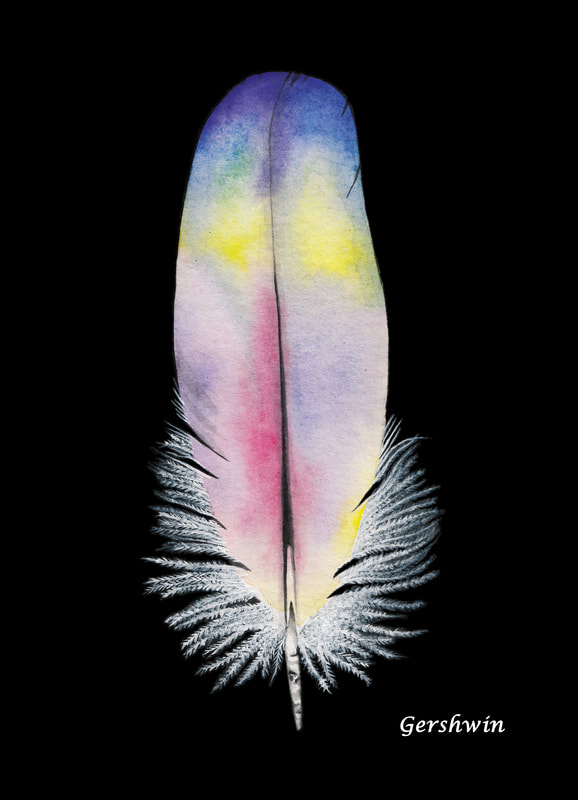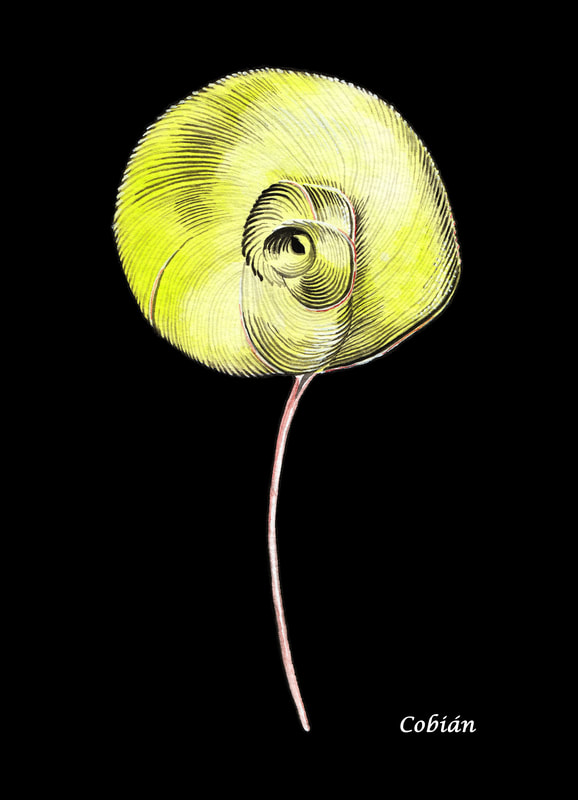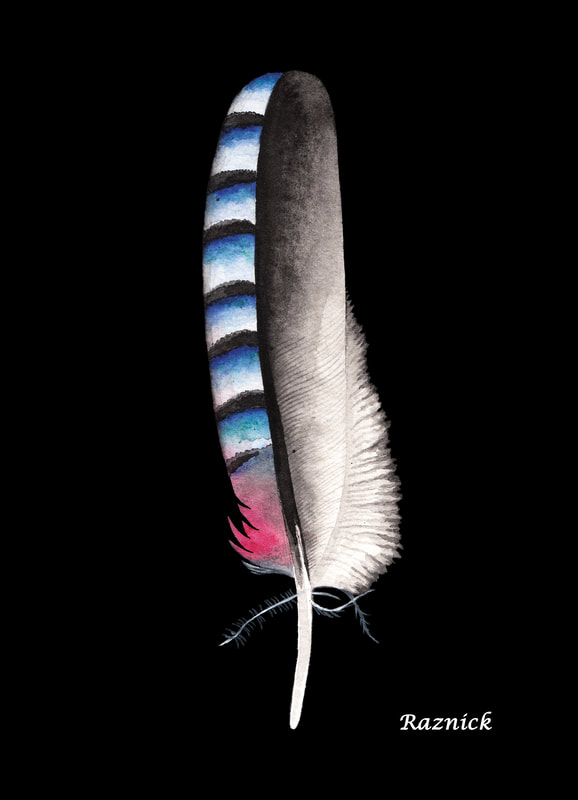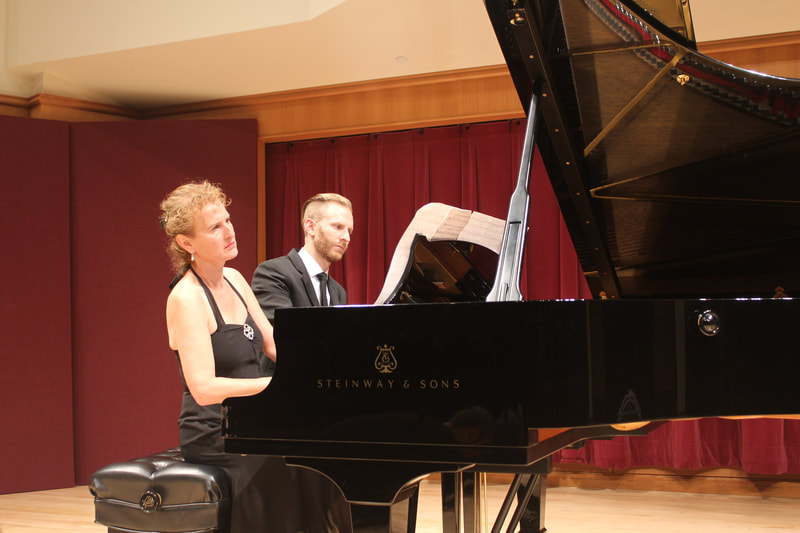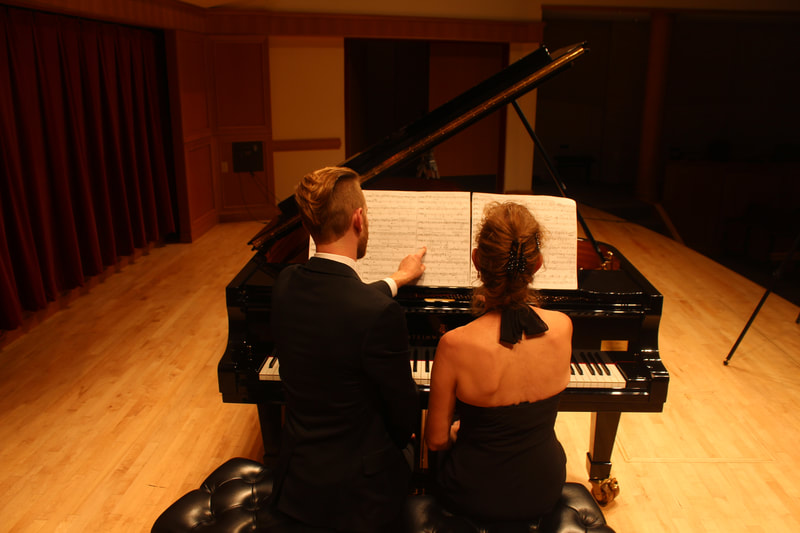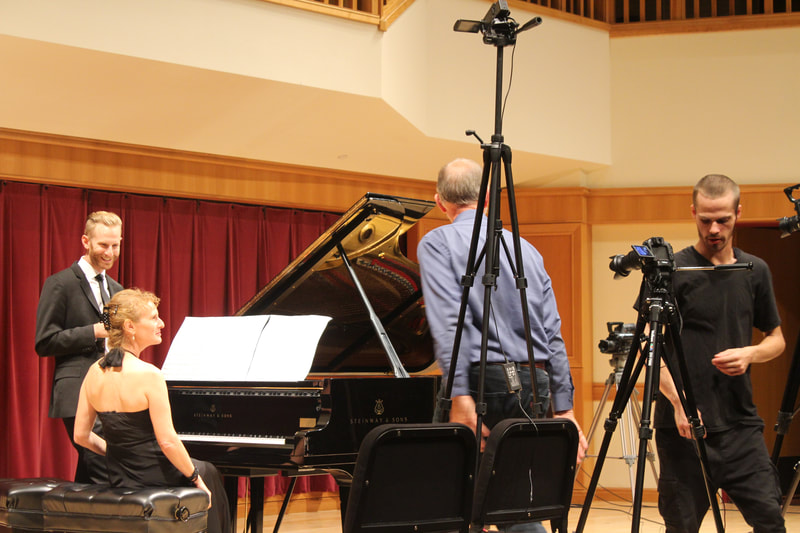Spanish: “Encuentro en Ben un fraseo interpretativo de la escuela pianística romántica y además un despliegue técnico formidable con una evidente influencia de los géneros populares latinoamericanos lo que lo hace un artista fresco y sorprendente."
English: “I find in Ben an interpretive phrasing of the Romantic pianistic school and furthermore a formidable technical display with an evident influence of Latin American popular genres, which makes him a fresh and surprising artist.”
-Nicolás Ledesma, Pianist/Composer, Latin GRAMMY® Winner
"Magnificent playing and recorded with remarkable clarity to capture all the nuance of Raznick's phrasing."
-Danaë Xanthe Vlasse, Pianist/Composer, 2022 GRAMMY® Winner
"This creative project artfully conveys the joy and love Ben Raznick has for the people in his life, the travels of his pursuits, and the fulfillment his music brings."
-Deborah De La Torre, La Cocodrila Latinx Jazz Pianist/Composer
"Ben Raznick is a creative genius. Ben and his team's attention to detail throughout this rich and layered production is spectacular."
-Stacey Stern, Executive Coach, Life & Leadership Coach
"A labor of love and exquisite multimedia effort."
-Martha Gershun, Consultant & Author
English: “I find in Ben an interpretive phrasing of the Romantic pianistic school and furthermore a formidable technical display with an evident influence of Latin American popular genres, which makes him a fresh and surprising artist.”
-Nicolás Ledesma, Pianist/Composer, Latin GRAMMY® Winner
"Magnificent playing and recorded with remarkable clarity to capture all the nuance of Raznick's phrasing."
-Danaë Xanthe Vlasse, Pianist/Composer, 2022 GRAMMY® Winner
"This creative project artfully conveys the joy and love Ben Raznick has for the people in his life, the travels of his pursuits, and the fulfillment his music brings."
-Deborah De La Torre, La Cocodrila Latinx Jazz Pianist/Composer
"Ben Raznick is a creative genius. Ben and his team's attention to detail throughout this rich and layered production is spectacular."
-Stacey Stern, Executive Coach, Life & Leadership Coach
"A labor of love and exquisite multimedia effort."
-Martha Gershun, Consultant & Author
|
|
|
|
About Birds of a Feather Album:
|
Ben Raznick’s Birds of a Feather takes you on a compelling journey through his classical piano album. For this project, Raznick compiles ten of his favorite composers and records some of their most captivating pieces on a gorgeous Steinway & Sons piano. Each work is presented in a professionally recorded video performance in Denver University’s Hamilton Hall. Each renowned composer is represented by a unique watercolor painted feather.
|
|
About Birds of a Feather Film:
|
Join Raznick as he brings you into his own living room for a cordial conversation and takes you behind the scenes of the creation and production of his project. Birds of a Feather Film is a reimagining of Raznick's Premiere Show, originally scheduled as a live debut in May of 2020, canceled due to the Covid-19 Pandemic.
|
|
A Note From Ben:
In 2016 I released my composition album, Memory Maze, a project born out of playing around on the piano decompressing from my master’s program and work in the field of education. The compositions I wrote reflected on styles and techniques from the variety of music I had studied over the years. This included genres I loved as a kid, like ragtime and classical jazz, the breathtaking music I studied from Argentina, Brazil and Spain, and many of my favorite melodies from western classical music. The fusion of all these styles blossomed into my compositions for Memory Maze. After releasing Memory Maze, I reflected deeper on my project and felt the natural progression would be to dive into, master and record these impressionable pieces of music that over the years I had built an emotional relationship with. And that is how Birds of a Feather began.
This project is a compilation of 16 pieces that have influenced me most by 10 of my favorite composers. The music is presented in chronological order by the composers' birth dates, beginning with Chopin born in 1809 and concluding with my own compositions. To prepare for this enormous undertaking, I worked with Dr. Tamara Goldstein, who challenged me to perform at my peak abilities. In our time working together, I drastically improved my technical skills and music conceptualization. Oftentimes Tamara would listen quietly as I played and then ask, “What are you thinking as you play this? Where are you? What does it look like? What’s happening when you get to this section?” I began to reflect on my music in a more profound way. Tamara taught me, among so many other lessons, how to tell a story. I’m honored that Tamara performs with me in Track 15, a duet arrangement of my composition, Memory Haze.
Recording in Denver University’s Hamilton Hall with Michael Schulze was a real treat. The audio was recorded on a pair of omnidirectional microphones spaced about 3 feet apart and 8 feet away from the piano. This setup allowed the recording to capture as much of the instrument as of the environment to recreate the sound of the 9’ Hamburg Steinway & Sons piano in a concert hall.
The cameras were put out of the way of the microphones, while also keeping the microphones out of the shot. When watching the videos, you do not see any microphones or cameras; however, you do hear the same sound as a high level classical piano recording session without video. Our setup gives you an impression that you’re watching a concert in the recital hall, even though you are not seeing any technology. I appreciated Michael’s philosophy, “Technology is at its best when it’s invisible.”
The videos were able to include 5 different angles, and I love that you get these close-up views of my hands playing. The views showcasing the movement and craftsmanship of the piano are incredible. I know as a spectator that so many times you walk into a gorgeous music hall, but from your seat you are stuck with one perspective in one location. Now, you get to be all over the hall and enjoy all of the views. An exciting thing about the videos was not only mastering the pieces, but putting together looks, including art through my feather bow ties.
I am so pleased with the stunning watercolor painted feathers that represent each composer. Tanja Hartlieb, my friend and housemate during my time in Buenos Aires, prepared all of the paintings in her hometown of Augsburg, Germany. Over a period of two years, Tanja, myself and my husband Shawn, shared many video calls to get each feather just right. Tanja shares, “The feathers were painted as usual watercolors, actually very simple. But never in my life have I used thinner brushes than for this project. With these brushes I was able to work on the small details of each individual feather. My inspiration was Ben’s input, his music and pictures of feathers 🪶.”
The reason this project is so fancy with this gorgeous feather theme, from the watercolor paintings to my bow ties, is because of my brilliant husband Shawn Johnson and his visionary mind. As creative director, he understood my goals and developed incredibly unique concepts from the smallest to the largest parts of this project.
It has been an absolute pleasure creating Birds of a Feather. The piano has always been one of my most honest and meaningful outlets for creativity. By spending time mastering my favorite pieces, I was able to fully immerse myself in the joy that piano has brought to my life. I hope I convey to you this beauty I experienced. Thank you from the bottom of my heart for your continued support.
With much love and appreciation,
This project is a compilation of 16 pieces that have influenced me most by 10 of my favorite composers. The music is presented in chronological order by the composers' birth dates, beginning with Chopin born in 1809 and concluding with my own compositions. To prepare for this enormous undertaking, I worked with Dr. Tamara Goldstein, who challenged me to perform at my peak abilities. In our time working together, I drastically improved my technical skills and music conceptualization. Oftentimes Tamara would listen quietly as I played and then ask, “What are you thinking as you play this? Where are you? What does it look like? What’s happening when you get to this section?” I began to reflect on my music in a more profound way. Tamara taught me, among so many other lessons, how to tell a story. I’m honored that Tamara performs with me in Track 15, a duet arrangement of my composition, Memory Haze.
Recording in Denver University’s Hamilton Hall with Michael Schulze was a real treat. The audio was recorded on a pair of omnidirectional microphones spaced about 3 feet apart and 8 feet away from the piano. This setup allowed the recording to capture as much of the instrument as of the environment to recreate the sound of the 9’ Hamburg Steinway & Sons piano in a concert hall.
The cameras were put out of the way of the microphones, while also keeping the microphones out of the shot. When watching the videos, you do not see any microphones or cameras; however, you do hear the same sound as a high level classical piano recording session without video. Our setup gives you an impression that you’re watching a concert in the recital hall, even though you are not seeing any technology. I appreciated Michael’s philosophy, “Technology is at its best when it’s invisible.”
The videos were able to include 5 different angles, and I love that you get these close-up views of my hands playing. The views showcasing the movement and craftsmanship of the piano are incredible. I know as a spectator that so many times you walk into a gorgeous music hall, but from your seat you are stuck with one perspective in one location. Now, you get to be all over the hall and enjoy all of the views. An exciting thing about the videos was not only mastering the pieces, but putting together looks, including art through my feather bow ties.
I am so pleased with the stunning watercolor painted feathers that represent each composer. Tanja Hartlieb, my friend and housemate during my time in Buenos Aires, prepared all of the paintings in her hometown of Augsburg, Germany. Over a period of two years, Tanja, myself and my husband Shawn, shared many video calls to get each feather just right. Tanja shares, “The feathers were painted as usual watercolors, actually very simple. But never in my life have I used thinner brushes than for this project. With these brushes I was able to work on the small details of each individual feather. My inspiration was Ben’s input, his music and pictures of feathers 🪶.”
The reason this project is so fancy with this gorgeous feather theme, from the watercolor paintings to my bow ties, is because of my brilliant husband Shawn Johnson and his visionary mind. As creative director, he understood my goals and developed incredibly unique concepts from the smallest to the largest parts of this project.
It has been an absolute pleasure creating Birds of a Feather. The piano has always been one of my most honest and meaningful outlets for creativity. By spending time mastering my favorite pieces, I was able to fully immerse myself in the joy that piano has brought to my life. I hope I convey to you this beauty I experienced. Thank you from the bottom of my heart for your continued support.
With much love and appreciation,
Birds of a Feather - Ben Raznick
01. Valse, Op. 64: No. 2 - Frédéric Chopin, 3:42, Ben Raznick (piano)
02. Consolation - Franz Liszt, 4:06, Ben Raznick (piano)
03. Cantos de España, Op. 232: IV. Córdoba - Isaac Albéniz, 6:01, Ben Raznick (piano)
04. Suite Bergamasque, L. 75: III. Clair de Lune - Claude Debussy, 4:52, Ben Raznick (piano)
05. May Song - Enrique Granados, 2:28, Ben Raznick (piano)
06. Winterreigen, Op 13: X. Postludium - Ernő Dohnányi, 1:42, Ben Raznick (piano)
07. The Entertainer - Scott Joplin, 3:58, Ben Raznick (piano)
08. Solace - Scott Joplin, 6:19, Ben Raznick (piano)
09. Maple Leaf Rag - Scott Joplin, 3:02, Ben Raznick (piano)
Sonata in E Minor, Movt. II - Florence Price, 3:30 (Available in Birds of a Feather Film from 34:55-38:25), Ben Raznick (piano)
10. Prelude I - George Gershwin, 1:48, Ben Raznick (piano)
11. Prelude II (Cadenza) - George Gershwin & Ben Raznick (Cadenza 2:41-4:17), 5:40, Ben Raznick (piano)
12. Prelude III - George Gershwin, 1:24, Ben Raznick (piano)
13. Los Mareados - Juan Carlos Cobián, arranged by Nicolás Ledesma, 4:31, Ben Raznick (piano)
14. Balada de Buenos Aires - Ben Raznick, 3:55, Ben Raznick (piano)
15. Memory Haze Duet - Ben Raznick, 3:39, Ben Raznick (piano), Tamara Goldstein (piano)
16. Barcelona Tango-Rag - Ben Raznick, 3:34, Ben Raznick (piano)
02. Consolation - Franz Liszt, 4:06, Ben Raznick (piano)
03. Cantos de España, Op. 232: IV. Córdoba - Isaac Albéniz, 6:01, Ben Raznick (piano)
04. Suite Bergamasque, L. 75: III. Clair de Lune - Claude Debussy, 4:52, Ben Raznick (piano)
05. May Song - Enrique Granados, 2:28, Ben Raznick (piano)
06. Winterreigen, Op 13: X. Postludium - Ernő Dohnányi, 1:42, Ben Raznick (piano)
07. The Entertainer - Scott Joplin, 3:58, Ben Raznick (piano)
08. Solace - Scott Joplin, 6:19, Ben Raznick (piano)
09. Maple Leaf Rag - Scott Joplin, 3:02, Ben Raznick (piano)
Sonata in E Minor, Movt. II - Florence Price, 3:30 (Available in Birds of a Feather Film from 34:55-38:25), Ben Raznick (piano)
10. Prelude I - George Gershwin, 1:48, Ben Raznick (piano)
11. Prelude II (Cadenza) - George Gershwin & Ben Raznick (Cadenza 2:41-4:17), 5:40, Ben Raznick (piano)
12. Prelude III - George Gershwin, 1:24, Ben Raznick (piano)
13. Los Mareados - Juan Carlos Cobián, arranged by Nicolás Ledesma, 4:31, Ben Raznick (piano)
14. Balada de Buenos Aires - Ben Raznick, 3:55, Ben Raznick (piano)
15. Memory Haze Duet - Ben Raznick, 3:39, Ben Raznick (piano), Tamara Goldstein (piano)
16. Barcelona Tango-Rag - Ben Raznick, 3:34, Ben Raznick (piano)
Credits:
Ben Raznick: Executive Producer, Pianist, Composer
Shawn Johnson: Creative Director, Associate Producer
Michael Schulze: Associate Producer, Engineer
Tamara Goldstein: Featured Pianist
Tanja Hartlieb: Visual Artist
Concept by Ben Raznick and Shawn Johnson.
Music in Tracks 14, 15, 16 and the Cadenza in Track 11 (2:41-4:17) Composed by Ben Raznick.
Mix, Mastering and Recording Engineers: Michael Schulze, Ben Raznick
Recorded between 10/9/2017-1/29/2019 on a 9’ Hamburg Steinway & Sons in Hamilton Hall, Denver University, Colorado.
Album Artwork: Tanja Hartlieb, Shawn Johnson, Ben Raznick
Graphic Design: Ben Raznick, Tanja Hartlieb
Animation: Ben Raznick
℗ © 2021 Ben Raznick (ASCAP) All Rights Reserved.
Shawn Johnson: Creative Director, Associate Producer
Michael Schulze: Associate Producer, Engineer
Tamara Goldstein: Featured Pianist
Tanja Hartlieb: Visual Artist
Concept by Ben Raznick and Shawn Johnson.
Music in Tracks 14, 15, 16 and the Cadenza in Track 11 (2:41-4:17) Composed by Ben Raznick.
Mix, Mastering and Recording Engineers: Michael Schulze, Ben Raznick
Recorded between 10/9/2017-1/29/2019 on a 9’ Hamburg Steinway & Sons in Hamilton Hall, Denver University, Colorado.
Album Artwork: Tanja Hartlieb, Shawn Johnson, Ben Raznick
Graphic Design: Ben Raznick, Tanja Hartlieb
Animation: Ben Raznick
℗ © 2021 Ben Raznick (ASCAP) All Rights Reserved.
Thank You…
…To my inspiring team, Shawn Johnson, Michael Schulze, Tamara Goldstein and Tanja Hartlieb. Each challenge we overcame over these past five years was worth the time, energy and patience. I am in awe of what we have achieved.
…To my loving and encouraging family, my mom Gail Raznick, my dad, Phil Raznick, my sister Emily Raznick, and my husband, Shawn Johnson. The son of a travel agency owner (my mom) and a deputy Sheriff (my dad) engrained in my childhood an equal mix of having an adventurous spirit while feeling protected. My parents and sister were my role models.
…To my 197 Kickstarter backers who believed in my vision. I couldn’t have done this without every single one of you.
…To the Recording Academy, Christen McFarland, Anna Frick and the San Francisco Chapter. Christen and Anna, your mentorship is invaluable. It is an honor to be a member of this network of talented and driven artists. I am so thrilled to submit Birds of a Feather for GRAMMY® consideration.
…To all of you who have listened and enjoyed my music. Music is a web that connects us all, and I’m honored that you’ve spent time listening to my art.
…To my loving and encouraging family, my mom Gail Raznick, my dad, Phil Raznick, my sister Emily Raznick, and my husband, Shawn Johnson. The son of a travel agency owner (my mom) and a deputy Sheriff (my dad) engrained in my childhood an equal mix of having an adventurous spirit while feeling protected. My parents and sister were my role models.
…To my 197 Kickstarter backers who believed in my vision. I couldn’t have done this without every single one of you.
…To the Recording Academy, Christen McFarland, Anna Frick and the San Francisco Chapter. Christen and Anna, your mentorship is invaluable. It is an honor to be a member of this network of talented and driven artists. I am so thrilled to submit Birds of a Feather for GRAMMY® consideration.
…To all of you who have listened and enjoyed my music. Music is a web that connects us all, and I’m honored that you’ve spent time listening to my art.
01. Valse, Op. 64: No. 2 - Frédéric Chopin, 3:42
|
Chopin’s waltz rapidly repeats short phrases reminding me of the almost invisible fluttering of a hummingbird's wings. Before you know it, the hummingbird has zipped up into the sky, similar to the right hand scale at the end of Chopin’s main passage. I have always loved to dance, and for that reason, I particularly enjoy the energy of this waltz where you can feel the 3-beat dance pattern.
About the composer: Frédéric Chopin (1809-1849) Born: Żelazowa Wola, Poland (6 miles from Warsaw, in what was then the Duchy of Warsaw, a Polish state established by Napoleon) Chopin, a composer and virtuoso pianist, wrote over 230 works. His own performances were noted for their nuance and sensitivity. When he moved to Paris, he befriended the next highlighted composer on this album, Franz Liszt, and the two performed together on seven occasions. Ben Raznick (piano) |
02. Consolation - Franz Liszt, 4:06
|
From Consolations, No. 3
Consolation highlights the feeling of support and comfort after a loss. I have always felt in this life that loss, in general, is perhaps one of the most powerful experiences that often can’t be described with words. And that is one of the reasons why I have always felt the piano was my refuge: a place where I could experience my emotions in a different way. This composition does a really wonderful job of highlighting, grief for example, a complex journey that has many layers. Due to the covid-19 pandemic, we have seen so much loss these past years, over one million deaths just in the United States. I send my condolences to those who are healing from loss. As we say in Judaism, “May the memory of your loved ones be for a blessing.” About the composer: Franz Liszt (1811-1886) Born: Raiding, Hungary (now Raiding, Austria) Liszt gained renown in Europe during the early nineteenth century for his prodigious virtuosic skill as a pianist. Apart from his more than 700 compositions, Liszt was the author of books about Frédéric Chopin and Hungarian Roma music. He was a teacher for young composers and future virtuosos like Edvard Grieg and Claude Debussy. Ben Raznick (piano) |
03. Cantos de España, Op. 232: IV. Córdoba - Isaac Albéniz, 6:01
|
From Chants d'Espagne, Op. 232
Ten years ago, I was lucky enough to have a job teaching English in Spain for two years. The first year, I was placed in a beautiful town, La Puerta de Segura, located in the southern region of Andalucía. This town in particular is lined with olive trees and olive oil is their main industry. On Memory Maze, my compositions, La Puerta de Segura and Olivos, are about my experiences in this town. My second year teaching was in the lovely city of Barcelona. Throughout my entire life, wherever I have lived, I have sought out a local piano teacher. This time I landed with a fantastic professor, Ludovica Mosca. She put this piece of music, Córdoba, in front of me, and I was immediately enchanted. As I play this composition, it reminds me of the cities of the Andalucía region with their romantic courtyard gardens and Moorish architecture, the vibrant culture and music like Flamenco, and of course, the tapas! About the composer: Isaac Albéniz (1860-1909) Born: Camprodón, Spain Albéniz utilized the melodic styles, rhythms, and harmonies of Spanish folk music. He introduced into his works the musical idioms native to the Andalucía region creating a blend of Spanish styles with contemporary European music. The titles of his works, such as Córdoba, evoke images of his native Spain. Albéniz’s works have become important to the repertoire of classical guitar. Ben Raznick (piano) |
04. Suite Bergamasque, L. 75: III. Clair de Lune - Claude Debussy, 4:52
|
From Suite Bergamasque, No. 3
Many will recognize this piece. The title means Moonlight, and that really does set the mood even before the pianist touches the keys. When I play this piece, I envision an evening sunset followed by the rise of a moon reflecting down brightly from the sky. For me, this piece is much like a deep thought. The brain begins to formulate a simple idea which naturally becomes deep and complex. But soon enough there is a light at the end of the tunnel, arriving and returning to the simplicity where it all started. About the composer: Claude Debussy (1862-1918) Born: Saint-Germain-en-Laye, France Claude Debussy embraced nontraditional scales and tonal structures and is considered one of the founders of musical impressionism. Similar to how Impressionist oil paintings use a technique of placing wet paint into wet paint to produce softer edges and intermingling of color, I love how the piano’s damper pedal can be pressed down to apply this technique musically, producing a melting of sounds. Ben Raznick (piano) |
05. May Song - Enrique Granados, 2:28
From Cuentos de la Juventud, Op 1. No. 3
Calming and tender, this piece belongs in a collection of pieces Granados titled, “Stories of Childhood.” Memories of my own childhood come to mind while playing this piece, like riding a bike in the warm sun after a long day at the swimming pool or draping myself across my grandmother’s couch and giggling when she would walk by and tickle my toes. The most challenging part of this piece is also the most beautiful: an ascending triple-over-duple polyrhythmic scale in the right hand.
About the composer: Enrique Granados (1867-1916)
Born: Lérida, Lleida, Spain
Granados was an acclaimed performer and educator. He opened his own school, Acadèmia Granados, in 1901 that became a leading institution for piano technique. His school continued from 1916 under Frank Marshall, then becoming known as Granados-Marshall Musical Association. They now have celebrated over 120 years since its founding.
Ben Raznick (piano)
Calming and tender, this piece belongs in a collection of pieces Granados titled, “Stories of Childhood.” Memories of my own childhood come to mind while playing this piece, like riding a bike in the warm sun after a long day at the swimming pool or draping myself across my grandmother’s couch and giggling when she would walk by and tickle my toes. The most challenging part of this piece is also the most beautiful: an ascending triple-over-duple polyrhythmic scale in the right hand.
About the composer: Enrique Granados (1867-1916)
Born: Lérida, Lleida, Spain
Granados was an acclaimed performer and educator. He opened his own school, Acadèmia Granados, in 1901 that became a leading institution for piano technique. His school continued from 1916 under Frank Marshall, then becoming known as Granados-Marshall Musical Association. They now have celebrated over 120 years since its founding.
Ben Raznick (piano)
06. Winterreigen, Op 13: X. Postludium - Ernő Dohnányi, 1:42
|
Like the moving parts of a movie projector that pick up speed upon commencing, the prominent left hand pattern quickly becomes a soft and reliable murmur in the background as the film begins and the right hand melody tells a story.
About the composer: Ernő Dohnányi (1877-1960) Born: Pozsony, Kingdom of Hungary, Austria-Hungary (today Bratislava, capital of Slovakia) Dohnányi used elements of Hungarian folk music in his compositions. In 1920, he became the Music Director of the Budapest Philharmonic Orchestra. Musicologist, James A. Grymes has presented research entitled "Ernst von Dohnányi: A Forgotten Hero of the Holocaust Resistance.” Among a list of resistant actions he took in Hungary during World War II to advocate for Jews, Dohnányi signed up to possibly hundreds of documents that saved Jewish lives during the Holocaust. Ben Raznick (piano) |
07-09. Scott Joplin Collection
|
Since I was a kid, my favorite music has always been rooted in the genius of Scott Joplin. There is no doubt about it, Joplin’s music is fun! The driver of that fun is a skillful and challenging technique.
In his work, Joplin utilized African American rhythms accompanied by melodies of gospel music. The left hand performs “stride” which is a technique of bouncing between bass notes up to chords, while the right hand sings melodies that are syncopated, meaning, they are off-beat. However, ragtime and the genre’s unique off-beat syncopation was mocked, minimized and suffered racial discrimination by the white community. In Joplin’s own words, “What is scurrilously called ragtime is an invention that is here to stay...That real ragtime of the higher class is rather difficult to play is a painful truth which most pianists have discovered. Syncopations are no indication of light or trashy music”. Joplin believed that his new genre of music was one of the African Americans’ chief contributions to American culture. About the composer: Scott Joplin (1868-1917) Born: Texarkana (The border of Texas and Arkansas), Texas, United States of America Deemed the “King of Ragtime”, Joplin composed over 100 original ragtime pieces, a ragtime ballet, and two operas. Joplin completed his opera, Treemonisha, in 1910, although it was never performed in its entirety in his lifetime. In 1976, Joplin received a posthumous Pulitzer Prize. |
07. The Entertainer - Scott Joplin, 3:58
As a childhood jump rope performer, my team and I commonly performed for basketball half time shows including the CU Buffs, Denver Nuggets, & an NBA All Star Game. This composition encapsulates my very experience as an entertainer: action-packed and fun!
Ben Raznick (Piano)
Ben Raznick (Piano)
08. Solace - Scott Joplin, 6:19
In this composition, each section is more beautiful than the last. The piece played in its entirety leaves me feeling deeply emotional. I love the delicate melodies over a Cuban habanera and/or tango rhythm. In this left hand rhythm, the stress falls on a dotted eighth note, a sixteenth note, and two eighth notes. I performed this piece at the memorial service for my childhood piano teacher, Judy Lambert, who encouraged me as a young pianist with kindness and courage.
Ben Raznick (Piano)
Ben Raznick (Piano)
09. Maple Leaf Rag - Scott Joplin, 3:02
|
Scott Joplin signed a contract with publisher John Stark on August 10th, 1899 for a one-cent royalty on all sales of Maple Leaf Rag. Maple Leaf Rag became the first piece of instrumental sheet music in the United States to sell more than one million copies! Maple Leaf Rag is one of the most famous of all ragtime pieces, and as a result, Joplin became known as the "King of Ragtime.”
Ben Raznick (Piano) |
|
Sonata in E Minor, Movt. II - Florence Price:
Available in Birds of a Feather Film
Due to the postponement in release of my project because of the Covid-19 Pandemic, I had time to reflect and realize that I hadn't included any compositions by women. I chose to correct that in my Birds of a Feather Film and highlight a brilliant American classical composer, pianist, organist and music teacher, Florence Price.
Price was born in 1887 in Little Rock, Arkansas, during the same era as Scott Joplin. Little Rock, during this period was considered a haven for its educated, middle class Black and skilled workers, many first generation born after the emancipation of their parents. Price’s father owned a successful dental practice and was also an award-winning painter. He was politically active and used his social position and wealth to continuously advance the causes of the community.
Price’s mother was a teacher who guided her early musical training. Price had her first piano performance at the age of four and went on to have her first composition published at the age of 11. By the age of 14, Price had graduated high school as valedictorian and enrolled in the New England Conservatory with a major in piano and organ.
Price faced a constant uphill battle as a Black American woman. She endured segregation, Jim Crow laws, racism, and sexism. Despite facing these systemic barriers, Price persevered and became the first Black American woman to have her music performed by a major symphony orchestra in Chicago in 1933. During her lifetime, Price composed over 300 pieces of music.
My discovery of Florence Price was within these past few years from my colleague, Deborah De La Torre. As part of our antiracism work, Deborah and I put together a book club and read a recently published biography on Florence Price’s life. I learned about an absolutely stunning Piano Sonata that Price wrote. I play an abbreviated version of the second movement in my film. I hope to record a complete version in the future to honor Florence Price as a composer whom I feel fortunate to include in Birds of a Feather.
Ben Raznick (Piano)
Due to the postponement in release of my project because of the Covid-19 Pandemic, I had time to reflect and realize that I hadn't included any compositions by women. I chose to correct that in my Birds of a Feather Film and highlight a brilliant American classical composer, pianist, organist and music teacher, Florence Price.
Price was born in 1887 in Little Rock, Arkansas, during the same era as Scott Joplin. Little Rock, during this period was considered a haven for its educated, middle class Black and skilled workers, many first generation born after the emancipation of their parents. Price’s father owned a successful dental practice and was also an award-winning painter. He was politically active and used his social position and wealth to continuously advance the causes of the community.
Price’s mother was a teacher who guided her early musical training. Price had her first piano performance at the age of four and went on to have her first composition published at the age of 11. By the age of 14, Price had graduated high school as valedictorian and enrolled in the New England Conservatory with a major in piano and organ.
Price faced a constant uphill battle as a Black American woman. She endured segregation, Jim Crow laws, racism, and sexism. Despite facing these systemic barriers, Price persevered and became the first Black American woman to have her music performed by a major symphony orchestra in Chicago in 1933. During her lifetime, Price composed over 300 pieces of music.
My discovery of Florence Price was within these past few years from my colleague, Deborah De La Torre. As part of our antiracism work, Deborah and I put together a book club and read a recently published biography on Florence Price’s life. I learned about an absolutely stunning Piano Sonata that Price wrote. I play an abbreviated version of the second movement in my film. I hope to record a complete version in the future to honor Florence Price as a composer whom I feel fortunate to include in Birds of a Feather.
Ben Raznick (Piano)
10-12. George Gershwin Collection
|
I have always loved how George Gershwin composes his pieces as a fusion of so many different genres. Gershwin is famous for so many different compositions. On many of my jump rope excursions, we would travel on United, who adopted Rhapsody in Blue as its theme song. For this reason, I quickly became fond of Gershwin’s music. I particularly like his Three Preludes because I feel like Gershwin took his coolest ideas and put them altogether for this series.
Gershwin first performed this collection at the Roosevelt Hotel in New York City in 1926. Originally planning to compose 24 preludes, the number was reduced to 7 in manuscript form, then reduced to 6 in public performance and further declined to 3 when first published in 1926. As I grow and strengthen my own artistry, I can identify with the way a grand idea can be trimmed down. While sometimes a necessary process, the chopping block is always painful! About the composer: George Gershwin (1898-1937) Brooklyn, New York City, United States of America Gershwin’s compositions are widely known and span both popular and classical genres. In 1924, Gershwin composed his first major orchestral work, Rhapsody in Blue. Gershwin soon started composing Broadway theater works with his brother, Ira Gershwin, before moving to Paris, inspiring his jazz-influenced orchestral piece, An American in Paris. |
10. Prelude I - George Gershwin, 1:48
Allegro ben ritmato e deciso
“Welcome!” Or is it, “Welcome?” The first prelude begins with a Bb blues pattern, but already in the second phrase, it leaves the listener hanging on a fermata over the Ab. As a young pianist, this piece always inspired me by the fun surprise of crossing hands, the growing excitement throughout the piece, and the challenging coordinated final scale of both hands with a firework ending.
Ben Raznick (Piano)
“Welcome!” Or is it, “Welcome?” The first prelude begins with a Bb blues pattern, but already in the second phrase, it leaves the listener hanging on a fermata over the Ab. As a young pianist, this piece always inspired me by the fun surprise of crossing hands, the growing excitement throughout the piece, and the challenging coordinated final scale of both hands with a firework ending.
Ben Raznick (Piano)
11. Prelude II (Cadenza) - George Gershwin & Ben Raznick, 5:40
Andante con moto e poco rubato
Somber yet steady, the second movement introduces an entirely different tone. I added my own improvisational passage in the second movement, which is why I added “Cadenza” to the title. My cadenza is from 2:41-4:17. Inspired by the way Prelude I gains steam to the end, my cadenza focuses on the B section and repeats it twice. Each repeat, however, I build in more improvisational ideas and energy. The left hand, which leads the melody in the original manuscript, playfully shares the melody with the right hand in the second repeat and then hands off the melody entirely by the third repeat. After my cadenza ends, we return to our regularly scheduled programing at 4:18.
Ben Raznick (Piano)
Somber yet steady, the second movement introduces an entirely different tone. I added my own improvisational passage in the second movement, which is why I added “Cadenza” to the title. My cadenza is from 2:41-4:17. Inspired by the way Prelude I gains steam to the end, my cadenza focuses on the B section and repeats it twice. Each repeat, however, I build in more improvisational ideas and energy. The left hand, which leads the melody in the original manuscript, playfully shares the melody with the right hand in the second repeat and then hands off the melody entirely by the third repeat. After my cadenza ends, we return to our regularly scheduled programing at 4:18.
Ben Raznick (Piano)
12. Prelude III - George Gershwin, 1:24
Agitato
Excitement prevails! There is not a dull moment in this short minute and a half. Incredibly challenging for the pianist in the last section, the left hand bounces up and down octaves in open fifths, twice per beat. Meanwhile, the right hand plays a syncopated melody in octaves. But my favorite part: In the midst of this organized chaos, Gershwin adds tricky interjections between each phrase, where the right and left hand both meet in the middle of the piano to work together for one short beat to share a melodic idea.
Ben Raznick (Piano)
Excitement prevails! There is not a dull moment in this short minute and a half. Incredibly challenging for the pianist in the last section, the left hand bounces up and down octaves in open fifths, twice per beat. Meanwhile, the right hand plays a syncopated melody in octaves. But my favorite part: In the midst of this organized chaos, Gershwin adds tricky interjections between each phrase, where the right and left hand both meet in the middle of the piano to work together for one short beat to share a melodic idea.
Ben Raznick (Piano)
13. Los Mareados - Juan Carlos Cobián, 4:31
|
Initially a piano work titled Clarita by the composer, the music was added to a play in 1922 and renamed Los dopados to maintain the same name as the play. The name Los Mareados finally prevailed in 1942 when bandoneón player, composer and tango orchestra director, Aníbal Troilo, recorded a version with new lyrics.
I was very fortunate in college to study abroad my junior year in Buenos Aires. When I was there, I fell in love with Argentina, and after graduating college, I decided to return to study tango and folklore, then recording my first album in Buenos Aires. During this period of time, I was connected to piano tango master and professor, Nicolás Ledesma, who offered to give me lessons. I remember taking the bus from the center of Buenos Aires to the neighborhood he lived in to visit his home for our lessons. As a novice trying to learn tango on the piano while also speaking Spanish as my second language was very challenging. But of course, I was also having a lot of fun. I learned from Mr. Ledesma, that how the tango is danced differently each time, that is also how he performs it on the piano. One lesson, he presented me with his own arrangement of the tango, Los Mareados, and I did my best to learn from his sheet music. However, it wasn’t until years later that I listened to his own performance and recording and realized he played his composition even more intricately and ornately than he had written it. He had so many pops and flairs that aren’t written in his sheet music. I wanted to capture all of these beautiful ideas that Mr. Ledesma did not write down, but rather had improvised. For this performance, to master his arrangement, I listened to his recording well over 100 times. I loved re-learning this piece in a different way, hopefully encapsulating the grand performance of maestro Nicolás Ledesma. About the composer: Juan Carlos Cobián (1896-1953) Born: Pigüé, Buenos Aires, Argentina Juan Carlos Cobián was an Argentine bandleader and tango composer. He led the evolutionary tendency in tango, or in other words, avant-garde tango. This transition of tango music culture was perceived as evolving towards concert music and distancing from traditional dance music. In fact, publishers did not accept Cobián’s early tangos because they regarded them as too far beyond the popular music of the time. |
|
Lyrics in Spanish:
Rara... como encendida te hallé bebiendo linda y fatal... Bebías y en el fragor del champán, loca, reías por no llorar... Pena Me dio encontrarte pues al mirarte yo vi brillar tus ojos con un eléctrico ardor, tus bellos ojos que tanto adoré... Esta noche, amiga mía, el alcohol nos ha embriagado... ¡Qué importa que se rían y nos llamen los mareados! Cada cual tiene sus penas y nosotros las tenemos... Esta noche beberemos porque ya no volveremos a vernos más... Hoy vas a entrar en mi pasado, en el pasado de mi vida... Tres cosas lleva mi alma herida: amor... pesar... dolor... Hoy vas a entrar en mi pasado y hoy nuevas sendas tomaremos... ¡Qué grande ha sido nuestro amor!... Y, sin embargo, ¡ay!, mirá lo que quedó… |
Lyrics translated in English:
Strange... As if you were burning That's how I found you, drinking Looking pretty and fatal... You were drinking And amidst the uproar caused by the champagne You laughed like crazy in order not to cry... Pity I felt pity when I found you Because when I looked at you I saw how your eyes shone With an electrical burning, Your beautiful eyes that I adored so much... Tonight, my friend, Alcohol has inebriated us... Who cares if everybody laughs While calling us 'the dizzy ones'! Everyone has sorrows And we have our own... This night we will drink Because we are not going to See each other again anymore... Today you will become part of my past The past of my life... My wounded soul carries three things Love... grief... pain... Today you will become part of my past Today we will start walking new paths... How great our love was!... And yet, alas, look at what is left now... |
14-16. Ben Raznick Collection
|
My Memory Maze compositions can be described as a musical journal detailing pivotal life experiences from my twenties. Much like mazes, my pieces have twists and turns throughout intricate passages. Many of my songs are designed like a puzzle, becoming increasingly challenging throughout, but with a solution at the end.
My compositions for this project are influenced by the music and culture of the locations where I have lived. The Memory Maze journey begins in Buenos Aires, ventures to Spain and then returns to my home, Colorado. I have chosen to share new recordings and renditions of the following three compositions to close out Birds of a Feather, including myself in the final flock of composers for this project. About the composer: Ben Raznick (1985- ) Born: Boulder, Colorado United States of America Ben Raznick has trained with piano professors in the United States, Argentina, Brazil and Spain. In his youth, Raznick participated in a local competitive jump rope team that took him on journeys across the United States and world to places like Puerto Rico, Canada, Belgium & Denmark to perform, teach and compete. By the age of 16, Raznick was a 2x Jump Rope World Champion and US Grand National Champion. Raznick cofounded and serves as president of Spotlight Foundation, a Denver based non-profit, working as a conduit for communities to support local charities and international organizations doing great work. After meeting and developing a partnership with Lázaro over the years following a 2004 Amigos organization visit to Nicaragua, Lázaro Project became an official initiative providing educational supplies, supplemental meals and health initiatives for students in Nicaragua. Raznick also serves as the president of Denver Area Music Teachers Association (DAMTA). Due to the hard work of Raznick and DAMTA’s board of directors, DAMTA was awarded 2022 Local Association of the Year, presented by the Colorado State Music Teachers Association (CSMTA) at their annual conference. |
14. Balada de Buenos Aires - Ben Raznick, 3:55
Not all people would agree that an interpretation of the bustling, cultural hub of Buenos Aires would be an emotional ballad. This piece instead reflects the sorrowful emotions of tango. Known to be intensely melancholic, the tango dance originated in gatherings of enslaved Africans, European immigrants, and working and lower classes of people in the 1880s along the Río de la Plata area, consisting of Buenos Aires, Argentina and Montevideo, Uruguay. I was taught in Argentina that the passion felt in the tango was a result of sadness, longing and homesickness of these people.
My original composition on Memory Maze features the bandoneón, a traditional tango instrument, accompanied by piano, violin, cello and double bass. This rendition for solo piano includes a variety of arpeggiated chords to represent the elegant and unpredictable movements between dance partners in the many tangos I witnessed in Buenos Aires.
I may never pinpoint exactly why tango reaches into my soul, however I do believe that because I was raised Jewish, I have always loved and been accustomed to music written in minor keys, typically sounding sad or serious.
Ben Raznick (piano, composer)
My original composition on Memory Maze features the bandoneón, a traditional tango instrument, accompanied by piano, violin, cello and double bass. This rendition for solo piano includes a variety of arpeggiated chords to represent the elegant and unpredictable movements between dance partners in the many tangos I witnessed in Buenos Aires.
I may never pinpoint exactly why tango reaches into my soul, however I do believe that because I was raised Jewish, I have always loved and been accustomed to music written in minor keys, typically sounding sad or serious.
Ben Raznick (piano, composer)
15. Memory Haze Duet - Ben Raznick, 3:39
Dedicated to Tamara Goldstein
My original composition from Memory Maze, entitled Memory Haze, describes the swirling of remnant thoughts from a chapter or era of life that has closed. I envision snowflakes lightly falling across the Rocky Mountains allowing for peaceful reflection and introspection.
Much of the emotion behind this song is about my own self-acceptance. I first came out as gay at the age of 18. It took another 10 years to truly feel comfortable with myself and confidently join the LGBTQ+ community. When I listen to my own theme, I feel proud of my journey and for overcoming many bumps in the road.
I rearranged my composition into Memory Haze Duet to record and perform with Tamara Goldstein. I performed the Secondo (lower part), and composed especially difficult passages for the Primo (upper part), knowing Tamara would be up for any challenge I presented. Performing this piece with Tamara was an honor.
Ben Raznick (piano, composer)
Tamara Goldstein (piano)
My original composition from Memory Maze, entitled Memory Haze, describes the swirling of remnant thoughts from a chapter or era of life that has closed. I envision snowflakes lightly falling across the Rocky Mountains allowing for peaceful reflection and introspection.
Much of the emotion behind this song is about my own self-acceptance. I first came out as gay at the age of 18. It took another 10 years to truly feel comfortable with myself and confidently join the LGBTQ+ community. When I listen to my own theme, I feel proud of my journey and for overcoming many bumps in the road.
I rearranged my composition into Memory Haze Duet to record and perform with Tamara Goldstein. I performed the Secondo (lower part), and composed especially difficult passages for the Primo (upper part), knowing Tamara would be up for any challenge I presented. Performing this piece with Tamara was an honor.
Ben Raznick (piano, composer)
Tamara Goldstein (piano)
16. Barcelona Tango-Rag - Ben Raznick, 3:34
Barcelona Tango-Rag is upbeat and lively, telling the adventure of a day-in-the-life of an international coastal city where Gaudi’s magical architecture truly inspires the creative mind. In a genre fusion of classical Spanish, tango and ragtime, there is a lot of fun to be had with this closing piece of my album. Recorded originally as a piano & castanet duet with Ludovica Mosca on my album Memory Maze, my Spanish professor and professional castanet player, this rendition is for solo piano.
Ben Raznick (piano, composer)
Ben Raznick (piano, composer)

